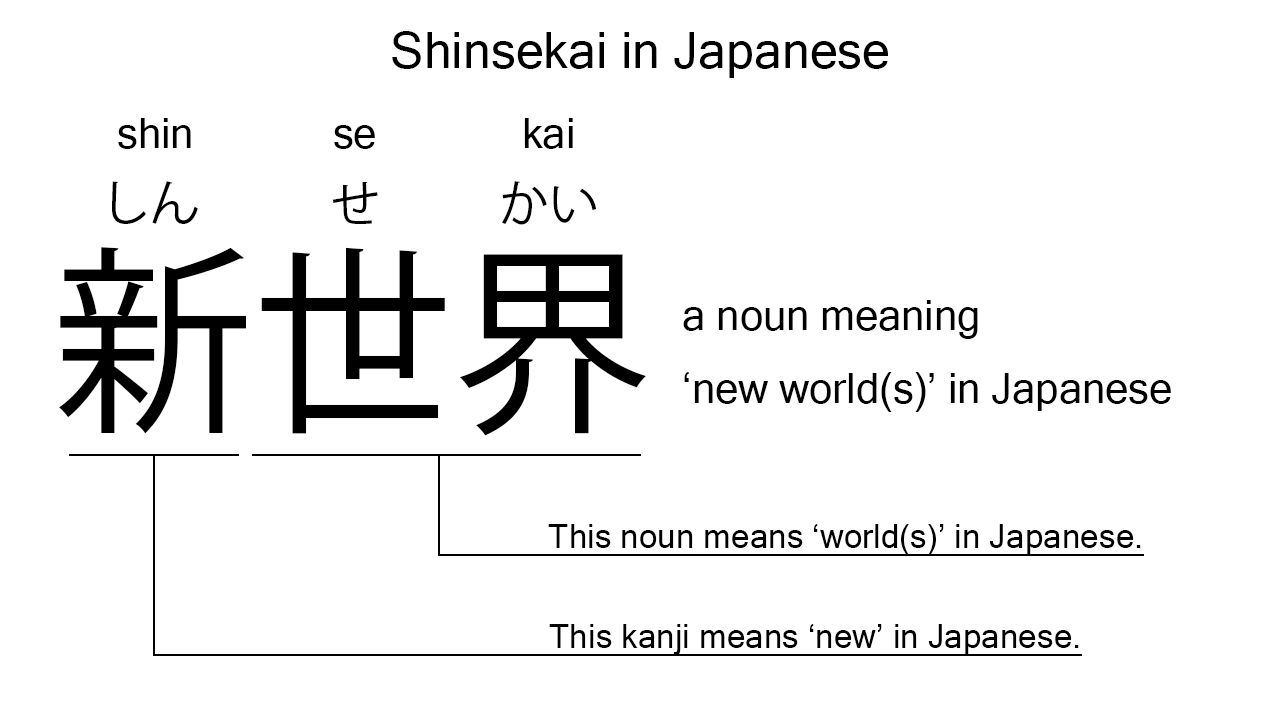What does “shinsekai” mean in Japanese?
Native speakers say “shinsekai” normally to mean a ‘new world’ in Japanese. Perhaps, some Japanese learners know this word as it is sometimes used in Japanese movies, songs, novels, manga, anime, and the like. In this blog post, however, I will explain this word in detail based on its grammatical components. And also, I will explain how to use it through example sentences. My explanations would help Japanese learners understand “shinsekai” more clearly. Then, let’s get started!
Contents
Definition and meaning of “shinsekai”
Let me start with the definition and meaning of “shinsekai”.
- shinsekai – 新世界 (しんせかい) : a noun meaning ‘new world’ in Japanese. This can also work as plural. Learn more about Japanese plural.
The definition and meaning are simple and clear. To understand this noun more clearly, however, let me explain its grammatical components in detail, one by one.
What does “shinsekai” literally mean in Japanese?
“Shinsekai” consists of the following two components:
- 新 : a prefix adding the meaning of ‘new’.
- 世界 : a noun meaning ‘world’ in Japanese.
These two components tell us that the formed noun literally means a ‘new world’ in Japanese. This literal interpretation is completely in line with the actual meaning.

When we meet new Japanese words, we should check their grammatical components in detail to understand their meanings clearly and deeply. In many cases, components tell us a lot about the meanings of the words they form. Actually, here, we could get the better understanding of “shinsekai” through the detailed check above.
So far, I’ve explained the definition and meaning of “shinsekai” together with its grammatical components. Then, let me explain how to use it through the example sentences below.
Example #1: how to say “new world” in Japanese
kanojo wa shinsekai kara ki ta – 彼女は新世界から来た (かのじょはしんせかいからきた)
She came from the new world.
Below are the new words used in the example sentence.
- kanojo – 彼女 (かのじょ) : a pronoun meaning ‘she’ in Japanese.
- wa – は : a binding particle working as a case marker or topic marker. In the example, this works after “kanojo” to make the subject in the sentence.
- kara – から : a case particle used to say where someone or something comes from. In the example, this is used after “shinsekai” to indicate the place where she came from.
- ki – 来 (き) : one conjugation of the verb, “kuru“, which means ‘to come’ in Japanese. In the example, it has been conjugated for the better connection with its following word.
- ta – た : an auxiliary verb used after a verb, adjective, or auxiliary verb to make its past tense form. Probably, this is well known as a part of Japanese ta form. In the example, this is used after “ki” to make its past tense form, “ki ta”.
This is a typical usage of “shinsekai”. In this example, it works together with the case particle, “kara”, to say “from the new world” in Japanese.
Example #2: another usage of “shinsekai”
watashi tachi wa shinsekai ni sume nai – 私達は新世界に住めない (わたしたちはしんせかいにすめない)
We cannot live in the new world.
Below are the new words used in the example sentence.
- watashi – 私 (わたし) : a pronoun meaning ‘I’ in Japanese.
- tachi – 達 (たち) : a suffix used after a noun or pronoun to make its plural form. In the example, this is used after “watashi” to make its plural form, “watashi tachi”, which means ‘we’ in Japanese.
- ni – に : a case particle used to say where someone or something is. In the example, this is used after “shinsekai” to indicate the place where the speakers cannot live.
- sume – 住め (すめ) : one conjugation of the potential verb, “sumeru”, which means ‘can live’ in Japanese. In the example, it has been conjugated for the better connection with its following word.
- nai – ない : an auxiliary verb used after a verb, adjective, or auxiliary verb to deny its meaning. In this example, this is used after “sume” to deny its meaning. Word orders in Japanese and English are different, but the role of this auxiliary verb is similar to that of “not”.
This is another typical usage of “shinsekai”. In this example, it works together with the case particle, “ni”, to say “in the new world” in Japanese. When we want to mean a ‘new world’ in Japanese, anyway, this noun is always a very good option.
Summary
In this blog post, I’ve explained the definition and meaning of “shinsekai” in detail based on its grammatical components. And also, I’ve explained how to use it through the example sentences. Let me summarize them as follows.
- shinsekai – 新世界 (しんせかい) : a noun meaning ‘new world’ in Japanese. This can also work as plural. This noun consists of two components, “shin” and “sekai”, which mean ‘new’ and ‘world’ respectively.
Hope my explanations are understandable and helpful for Japanese learners.